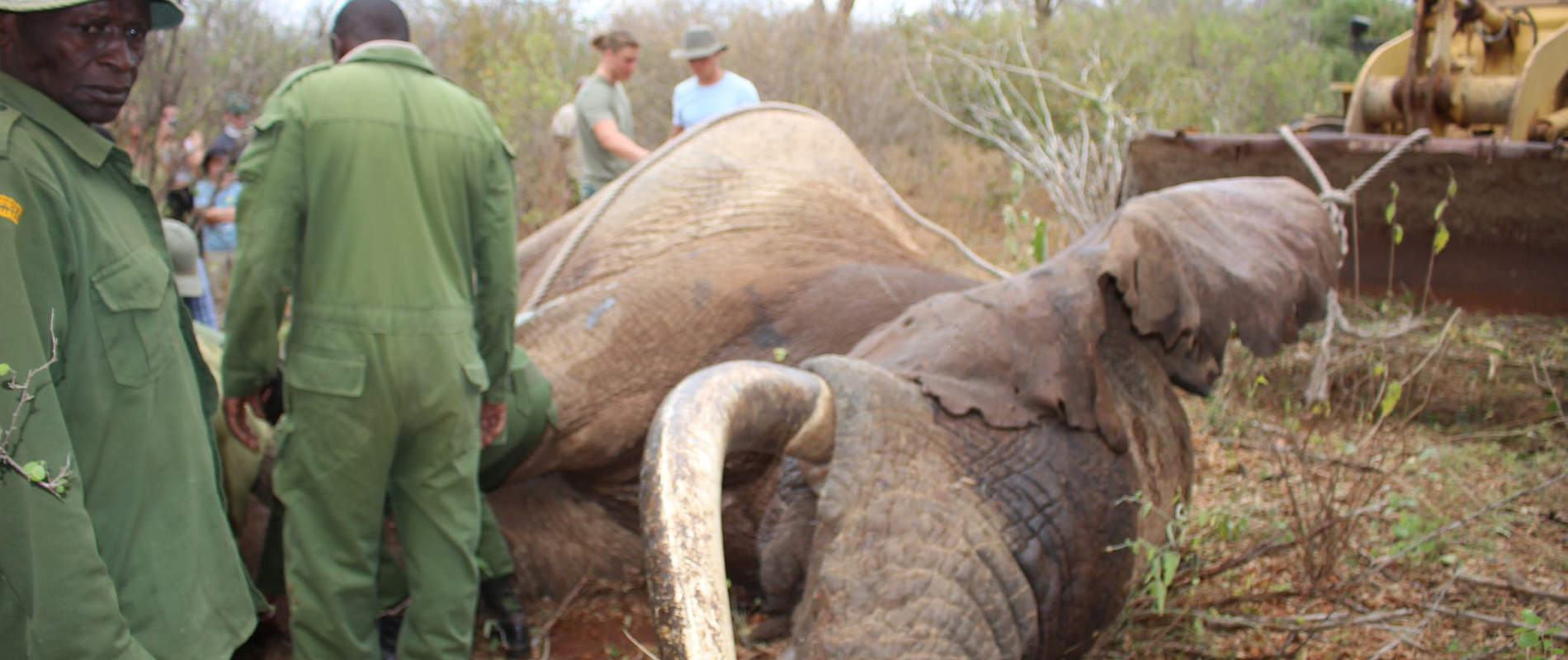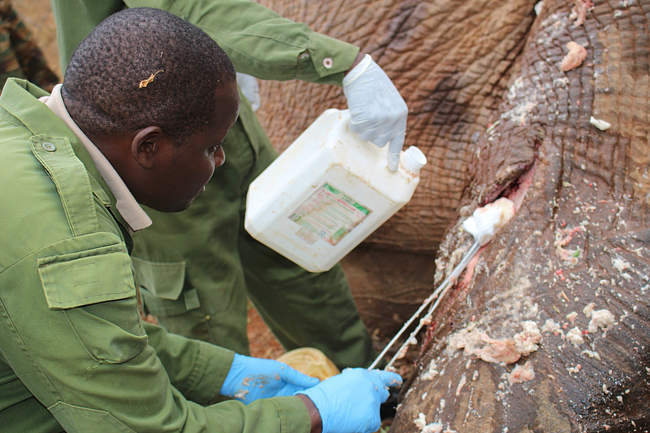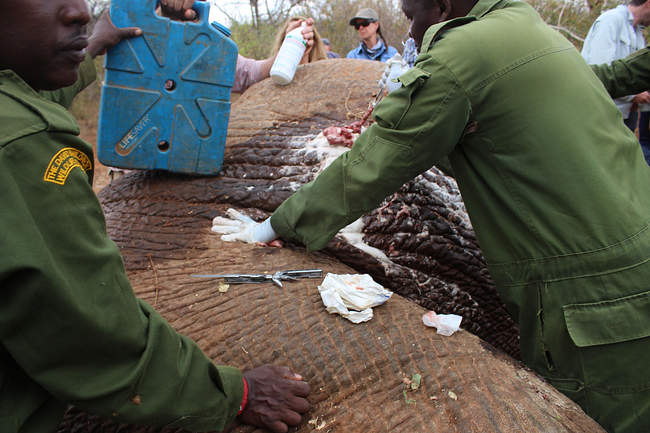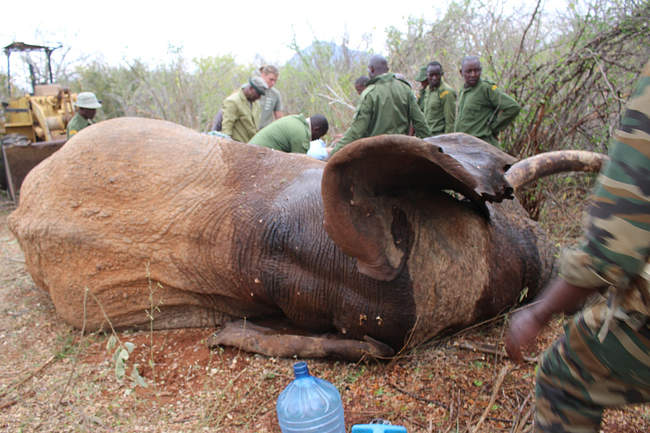The Month of July 2018 witnessed a sharp increase in case numbers due to an increase in human-wildlife conflict related problems around Mwatate/Bura area involving livestock predation by Lions. Reported by Dr Jeremiah Poghon Unit veterinarian Introduction The Month of July 2018 witnessed a sharp increase in case numbers due to an increase in human-wildlife conflict related problems around Mwatate/Bura area involving livestock predation by Lions
C
Other cases undertaken within the month were removal of Elephants from the new Tsavo east Rhino sanctuary into the bigger Tsavo East National Park, rescue of a Lion that had fallen into a well at Voi safari lodge, autopsy of a security dog after sudden death in Kaluku kennels, examination and euthanasia of a Giraffe involved in a vehicle accident inside Tsavo East National Park and a problem Lion whose leg was amputated by a wire snare. Others were an Elephant bull treated for two arrow wounds at Ithumba, Black Rhino attacked by Lions was treated in Tsavo East, 7 problem lions captured from Mwatate/ Bura area and moved to Tsavo East National Park and an Elephant calf that fell into a hole rescued and reunited with the mother at Amboseli National Park.
CASE#1 ELEPHANT TRANSLOCATION OUT OF TSAVO EAST RHINO SANCTUARY
Date: 9th July 2018
Species: 14 Elephants
Sex: 8 bulls, 4 cows and 2 young ones.
Age: Various
Place: Sobo, Tsavo East.
History: The remnant Elephant population left inside the new Tsavo East Rhino sanctuary were earmarked for immobilization and removal from the sanctuary after Helicopter drive failed to move them out of the sanctuary. The Elephants were darted from a helicopter and driven near the fence line or near open areas for easier loading into lorries. The operation took 2 days.

Immobilization and treatment: The bulls were immobilized using 18 mgs of Etorphine Hcl, while 16 mgs was used to immobilise the cows. Sub-adults 10 and 5 mgs were used to immobilise them while one small calf was restrained manually. A total of 205 mgs was used in the operation. The Elephants were darted from a Helicopter and pushed to areas easily accessed by ground teams then loaded into open trucks in lateral recumbency. Water was splashed to cool them. The elephants were transported out of the sanctuary to be released. The anaesthesia reversed before the Elephants were left to walk away.
CASE#2 LION RESCUE EXERCISE
Date of intervention: 10th July 2018
Animal: Lion
Species: Panthera leo
Sex: Male
Age: Adult
Location: Voi wildlife lodge, Tsavo East.
History: The Lion was reported by Voi wildlife lodge staff having fallen into a well previously used by the lodge to water its gardens. The Lion was trapped in the well and was struggling to climb out in vain. The well was about 10 metres deep and water level about 2 feet deep.

Immobilization, treatment and collaring: The lion was hooked into a looped rope and darted with 300 mgs of Ketamine and 4 mgs of Meditomidine Hcl and left for the drug to take effect then pulled out of the well with assistance of the lodge staff and a vehicle. The Lion was blindfolded then treated with long acting Amoxicillin Hcl and Dexamethasone Hcl both administered intramuscularly. The wounds caused by struggling were cleaned with tincture of Iodine and sprayed with topical Oxytetracycline antibiotic spray. He was loaded into a vehicle and transported to Tsavo East National Park then placed under a tree.

Reversal and prognosis: Anaesthesia was reversed one and half hours later using Yohimbine Hcl and he was monitored until he woke up and moved away.
CASE#3 AUTOPSY OF A SECURITY DOG
Date of Autopsy: 16th July 2018
Animal: Dog
Species: Canine
Sex: Female
Age: Adult
Location: Kaluku, Tsavo East
The sudden death of a KWS security dog based at DSWT Kaluku kennels was reported on the morning of 16th July. The only clinical sign observed on the dog the evening before was anorexia and later found dead in the morning.

Physical examination revealed a distended abdomen and attempts to drink water. The feed was still intact in the plate. All orifices were clean with no excretions. On opening all the organs were normal apart from a massively distended stomach that exerted a lot of pressure on internal organs and the lungs. The cause of death was put as Gastric dilatation-volvulus (GDV).
ASE#4 EXAMINATION OF AN INJURED GIRAFFE
Date of intervention: 20th July 2018
Animal: Giraffe
Species: Giraffa camelopardalis
Sex: Female
Age: Adult
Location: Voi-Aruba road, Tsavo East
Tourists travelling along the Voi-Aruba road within Tsavo East National Park reported a Giraffe which was beside the road writhing in pain and with an obvious fracture.

The vet team rushed to the location to find the Giraffe flat on the ground with left hind limb completely broken just below the hock joint. The cause of the accident seems to be a speeding vehicle as the Giraffe was lying by the road with clear bruise injuries apart from the fracture. Due to poor prognosis of the complete fracture of Tibial and fibula bones the Giraffe was euthanized for animal welfare issues.
Our Mobile Vet Units are in the field every day saving wild lives
CASE#5 LION EXAMINATION
Date of intervention: 23rd July 2018
Animal: Lion
Species: Panthera leo
Sex: Male
Age: Adult
Location: Mtito Andei, Tsavo East.
Examination and Diagnosis: Problem Lions are a growing concern in Tsavo East National Park. Human-wildlife conflict leads to change of attitude in the community towards wildlife and at times leads to the community retaliating towards the wildlife. The Lion was trapped near Mtito Andei after causing serious trouble within the community around the area. He was brought to Tsavo vet unit for examination.

Examination revealed poor body condition and complete amputation of the right hind leg just below the hock joint from a suspected wire snare placed to trap wild game. Predators usually resort to killing livestock after they are either too old to hunt or injured as was in this case. The Lion was euthanized for animal welfare concerns as he couldn’t survive in the wild.
CASE#6 TREATMENT OF AN ELEPHANT BULL
Date: 23rd July 2018
Species: Loxodanta Africana (African Elephant)
Sex: Male
Age: Adult
Location: Ithumba,Tsavo East National Park
History: A report of an injured Elephant bull was received from the David Sheldrick Wildlife Trust field headquarters offices at Kaluku within Tsavo. The bull was spotted that morning near a watering hole with pus oozing out of two arrow wounds on the front leg and chest area. The vet was airlifted from Voi to Ithumba by DSWT aircraft and found a team made up of fixed wing aircraft, Helicopter and ground teams waiting.

Immobilization, examination and treatment: Darting equipment and drugs were prepared containing 18 mgs of M99. The Elephant bull was driven by a chopper to an open field and darted using 18 mgs of Etorphine. The Elephant ran back deep into thick bush ignoring the chopper. An arrow head was clearly visible from the chopper. He went down in a thickly wooded area. The vet was dropped in an open field and directed by the chopper to where the Elephant fell.
The trunk and the ear were positioned correctly to aid in breathing and temperature control. The bull had an arrow wound on the right front leg lateral to the elbow joint with pus oozing out. The wound was cleaned by using water mixed with hydrogen peroxide, necrotic tissues and pus were removed then doused with tincture of iodine. Green clay was used to cover the wound. Long acting antibiotics were administered intramuscularly and dexamethasone Hcl given intravenously through the ear.
The Elephant was rolled over by aid of a road grader. The second arrow wound was also cleaned and antibiotic spray and green clay were applied. This was a clear case of attempted poaching.
Reversal and prognosis: After all the treatment was done, the rest of the team were instructed to clear the site as the vet administered the reversal drug. Anaesthesia was reversed using Diprenorphine at 3 times the etorphine dose. The Elephant struggled to stand and was assisted with a rope looped on the upper tusk. He stood up and walked away. Prognosis is good.
CASE#7 TREATMENT OF AN INJURED RHINO
Date: 24th July 2018
Species: Loxodanta Africana (African Elephant)
Sex: Male
Age: Adult
Location: Ndara, Tsavo East National Park
History: The Rhino under review was brought in from Nairobi National Park during the recent Rhino translocation exercise and placed in a Boma inside Tsavo East National Park new Rhino sanctuary. He was released from the Boma on the morning of 4th July 2016. On the evening of 22nd July 2018 reports of injury on the Rhino by suspected Elephant attack was received with visible bleeding on the upper pelvic region and lameness.
Immobilization, examination and treatment: A dart was prepared containing 4.5 mgs of Etorphine mixed with 80 mgs of Azaperone. The Rhino was darted on the thigh from a vehicle at 10:48 AM and went down at 10:58 AM having moved a short distance. Five mgs of Butorphanol mixed with 2 cc Doxopram was administered intravenously through the ear vein to stabilise his breathing. There were bite wounds and numerous scratch wounds on the lumbo-sacral area with bleeding.

The wounds were cleaned using Tincture of Iodine, sprayed with Oxytetracycline spray and covered with green clay to prevent fly contamination and birds pecking. 80 cc of long acting Amoxicillin together with 40 cc of Dexamethasone were administered intramuscularly.
Reversal and prognosis: Anaesthesia reversal achieved by administration of Diprenorphine at three times the Etophine dose, that’s 15 mgs. The Rhino woke up and moved away slowly.
CASE#8 PROBLEM LION CONTROL
Date of intervention: 26-27th July 2018
Animal: Lion
Species: Panthera leo
Sex: 2 Females and 5 cubs
Age: Adult and cubs
Location: Bura mwatate, Tsavo East.
History: Complaints from the community living within Bura and Mwatate areas of lions killing their livestock, which led to demonstrations in the area.
Capture and translocation: The KWS put together a team of community and problem animal control unit rangers and the vet unit to track and relocate the lions back to the park. Two Lionesses were found, one with four 4 month old cubs and another with one 1 year old cub. Darts were prepared containing 300 mgs of Ketamine Hcl and 4 mgs Meditomidine Hcl and the lionesses were darted.

The 1 year old cub was darted using 100 mgs of Ketamine and 1 mg of meditomidine while the 4 month old cubs were captured by hand. The Lionesses and cubs were put in three cage traps and relocated to Aruba area of Tsavo East National Park then released, each Lioness with her cubs. The problem has since cooled down and the community are happy.
CASE#9 RESCUE OF AN ELEPHANT CALF IN AMBOSELI
Date of intervention: 30th July 2018
Animal: Elephant
Species: Loxodanta Africana
Sex: Calf
Age: 3 years
Location: Amboseli National Park
History: Reports of an Elephant calf that fell into a hole in Amboseli National Park was received from the senior warden. The mother was keeping watch over the calf and hence was impossible for people to get near the hole and assist the poor calf out of her misery. Several attempts made to drive away the mother in order to help the calf failed hence assistance was sought from the Tsavo vet unit as the Amboseli vet unit was away. The vet tem was airlifted to Amboseli by DSWT aeroplane to attend to the case.

The Rescue: The team arrived at the site about an hour later, the best option was for the mother to be immobilized, calf rescued and then reunited again. Immobilization drugs were prepared made up of 16 mgs Etorphine Hcl in a Daninject darting system. The cow was darted on the rump and went down after 7 minutes. The trunk was well positioned for proper respiration. Ropes tied onto a tractor were hooked around calf and it was successfully pulled out the hole. He stood up and gestured looking for his mother.
Reversal and prognosis: The mother was woken up by use of Diprenorphine at 3 times the etorphine dose and reunited with her calf. They both walked away calmly. The calf did not sustain any injuries whilst in the hole. Prognosis for both mother and calf is good.
OTHER ACTIVITIES
The unit administered Trypanasomosis prophylactic drugs on 5 dogs, 2 based at Kaluku DSWT kennels and 2 based at Ngulia Rhino sanctuary kennels. The unit also examined several wildlife trophies/parts brought in from Makindu and Voi.
Acknowledgement
Report written by KWS Vet Dr Jeremiah Poghon. The unit acknowledges the support of its sponsors ViER PFOTEN through the David Sheldrick Wildlife Trust (DSWT) for their immense financial contribution to the unit. We also thank Kenya Wildlife Service through the Assistant director Tsavo conservation area and the head, veterinary and capture services department for their support.



